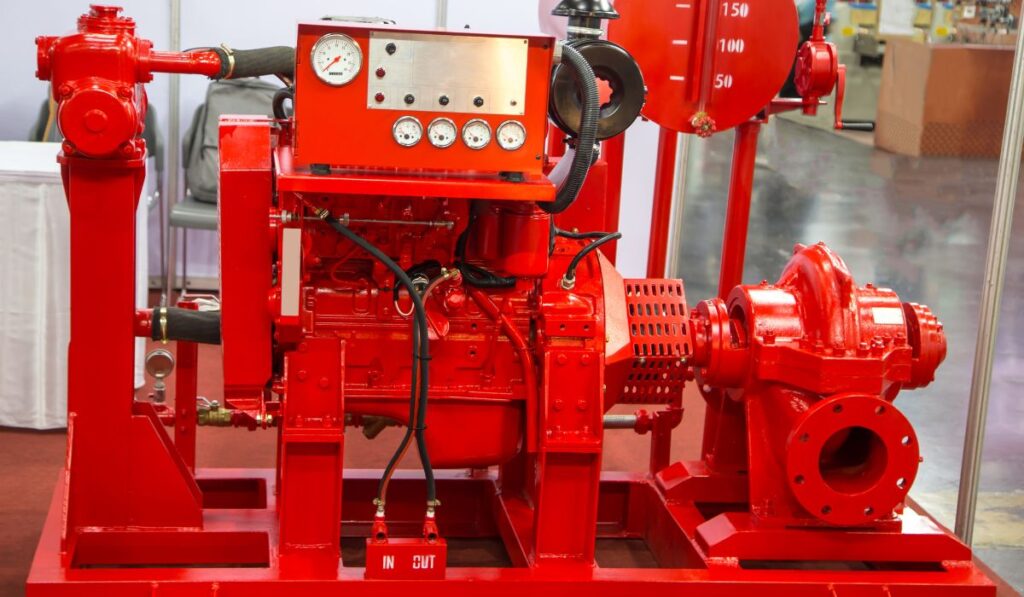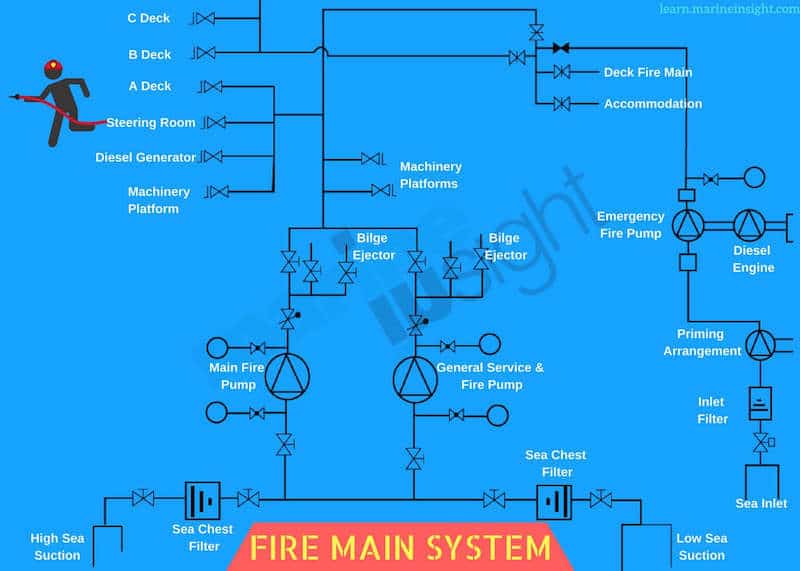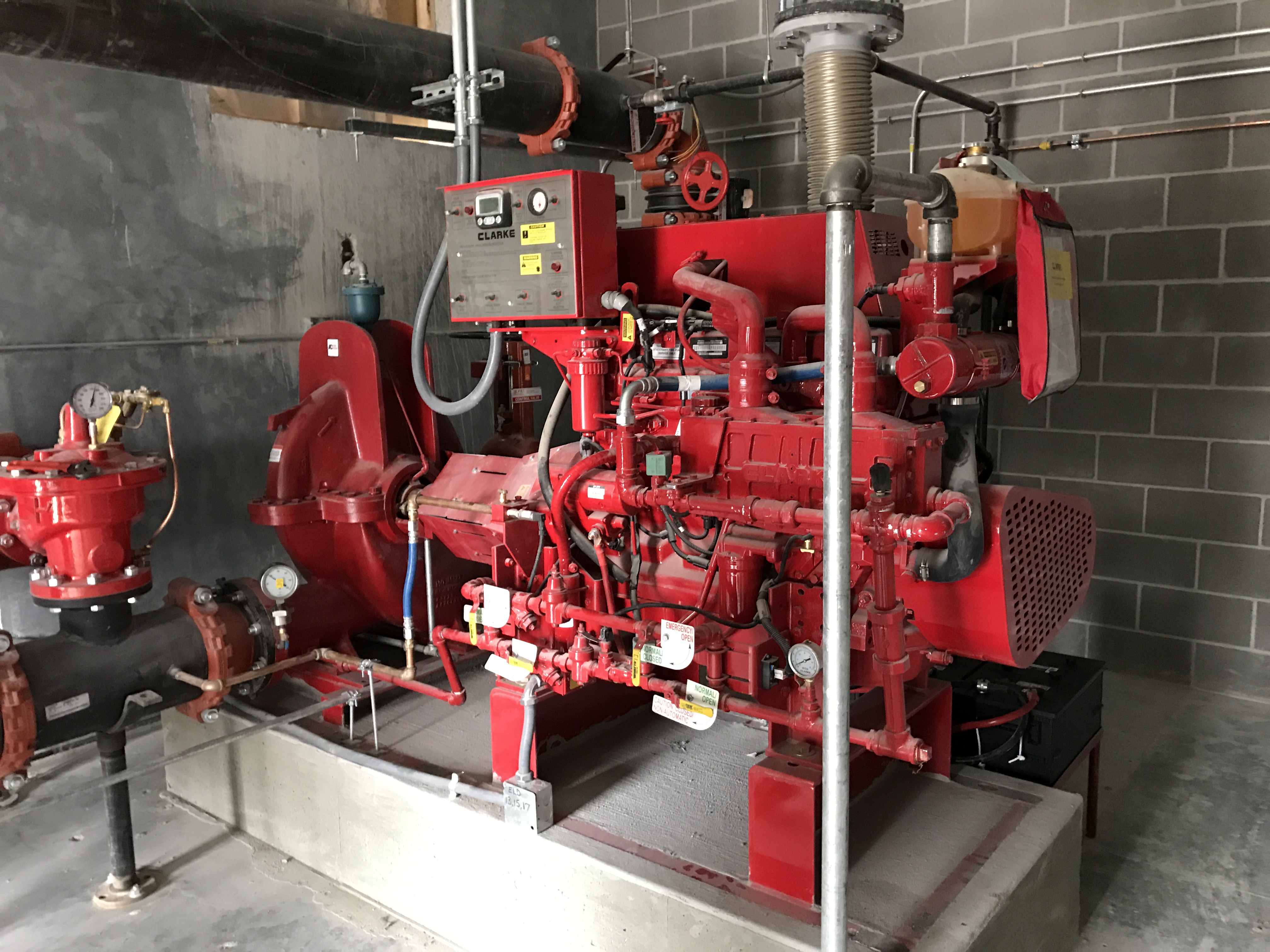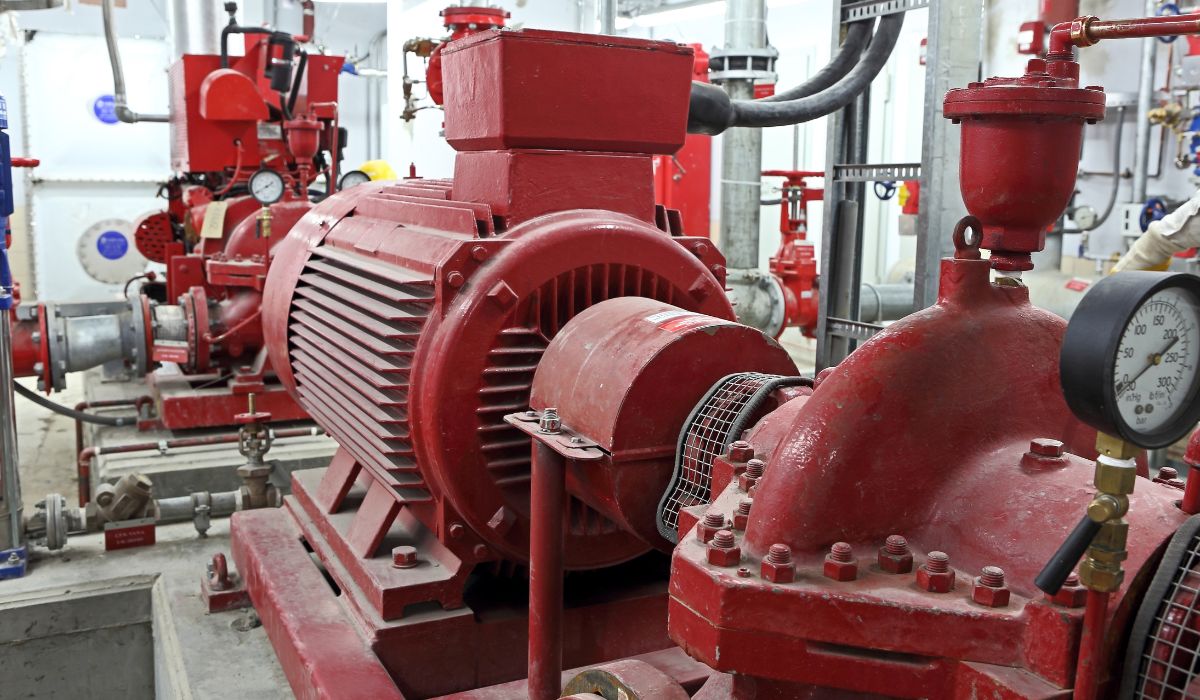A fire pump is required when the water supply cannot meet the fire sprinkler system’s demand. It ensures adequate water pressure and flow.
Fire pumps play a crucial role in fire protection systems. These pumps ensure that water pressure remains sufficient during a fire emergency. They become essential in high-rise buildings, large commercial spaces, and areas with low water pressure. Fire pumps activate when the sprinkler system detects a fire, providing immediate and adequate water flow.
Proper installation and maintenance are vital for their efficiency. Building codes and insurance requirements often mandate fire pumps. Ensuring your building meets these standards can save lives and property. Always consult fire protection experts to determine the necessity of a fire pump for your specific building.
Fire Pump Basics
Fire pumps play a crucial role in maintaining safety. They ensure water reaches all areas during a fire emergency. Understanding fire pump basics is vital for proper fire safety management.
Purpose Of Fire Pumps
The main purpose of fire pumps is to provide adequate water pressure. They help in distributing water to fire sprinkler systems. Fire pumps are activated when the system’s water pressure drops below a certain level. They ensure the fire sprinkler system operates effectively during a fire.
Types Of Fire Pumps
There are several types of fire pumps, each serving different needs. Here are the common types:
- Horizontal Split-Case Pumps: These are the most common and reliable. They are easy to maintain and have a long life.
- Vertical Split-Case Pumps: These are similar to horizontal pumps but take up less space. They are ideal for buildings with limited floor space.
- Vertical Turbine Pumps: These are used when the water source is below ground. They are suitable for wells or underground tanks.
- End Suction Pumps: These are compact and cost-effective. They are used in smaller buildings.
- In-Line Pumps: These are simple in design and easy to install. They are used in systems where space is a constraint.
Each type of fire pump has its advantages. The choice depends on the specific needs of the building and water source.
| Type of Fire Pump | Key Features |
|---|---|
| Horizontal Split-Case Pumps | Reliable, easy to maintain, long lifespan |
| Vertical Split-Case Pumps | Space-saving, similar reliability to horizontal pumps |
| Vertical Turbine Pumps | Ideal for below-ground water sources |
| End Suction Pumps | Compact, cost-effective |
| In-Line Pumps | Simple design, easy to install |
Choosing the right fire pump is essential for effective fire safety. Always consult with a fire safety expert to determine the best option for your building.

Building Regulations
Understanding when a fire pump is required is crucial for building safety. Building regulations dictate the necessity of fire pumps in certain structures. These regulations ensure that buildings are equipped to handle fire emergencies effectively.
Code Requirements
Fire codes provide guidelines for installing fire pumps in buildings. National Fire Protection Association (NFPA) 20 outlines specific requirements. Buildings above a certain height need a fire pump.
NFPA 13 details fire sprinkler systems, which may require a fire pump. High-rise buildings and large spaces often need these systems. Here is a table summarizing key code requirements:
| Code | Requirement |
|---|---|
| NFPA 20 | Fire pump installation in high-rise buildings |
| NFPA 13 | Sprinkler systems needing fire pumps |
Local Standards
Local building codes can vary from one place to another. Some regions have stricter fire safety standards. Consult local authorities to understand specific fire pump requirements.
Here are common local standards for fire pumps:
- Building height thresholds
- Occupancy types needing fire pumps
- Water supply requirements
Local codes may also dictate fire pump maintenance schedules. Regular inspections ensure the system’s reliability during emergencies.
High-rise Buildings
Fire safety in high-rise buildings is crucial. These buildings are taller than 75 feet. Fire pumps play a vital role in ensuring safety. They help maintain water pressure for firefighting efforts.
Height Considerations
High-rise buildings need fire pumps. The height makes it hard for water to reach upper floors. City water pressure is often not enough. A fire pump boosts the pressure. This ensures water reaches every floor.
Pressure Demands
Fire pumps meet the pressure demands of high-rise buildings. Taller buildings need higher water pressure. Fire pumps ensure sprinklers and hoses work well. This is essential for putting out fires.
| Building Height | Water Pressure Needed |
|---|---|
| 75-150 feet | 35-50 psi |
| 150-300 feet | 50-75 psi |
| 300+ feet | 75+ psi |
Fire pumps make sure the pressure is high enough. They are essential for the safety of high-rise buildings. Without them, water may not reach the fire.

Credit: www.marineinsight.com
Commercial Properties
Commercial properties require robust fire safety measures. Fire pumps are critical in ensuring safety. They maintain water pressure during a fire. Knowing when a fire pump is required helps in compliance and safety.
Occupancy Types
Different occupancy types determine fire pump needs. High-occupancy buildings like offices and malls require fire pumps. These buildings have many people, increasing fire risks.
- Offices
- Shopping malls
- Hotels
Low-occupancy buildings may not need fire pumps. These include small shops or storage facilities.
Fire Load Analysis
Fire load analysis evaluates the potential fire risk. High fire load means more combustible materials. Buildings with high fire loads require fire pumps.
| Building Type | Fire Load |
|---|---|
| Warehouse | High |
| Office | Medium |
| Small Shop | Low |
Fire load analysis is vital for safety. It helps decide if a fire pump is needed.
Residential Buildings
Fire pumps are essential for ensuring safety in residential buildings. They provide adequate water pressure to extinguish fires. Different residential buildings have different requirements for fire pumps.
Single-family Homes
In single-family homes, fire pumps are not always required. These homes usually rely on local water pressure. But in some cases, a fire pump might be necessary.
- Large homes with extensive square footage
- Homes in remote areas with low water pressure
- Homes with unique fire hazards, like large basements
Local building codes will determine the need for a fire pump. Always check with local authorities.
Multi-family Dwellings
Multi-family dwellings have different fire safety needs. These buildings include apartments and condominiums. Fire pumps are more common in these settings.
| Building Type | Fire Pump Requirement |
|---|---|
| Low-rise Apartments | Not always required |
| High-rise Apartments | Often required |
| Condominiums | Depends on height and structure |
High-rise buildings often need fire pumps for adequate water pressure. The number of units and building height can affect this requirement.
Check local building codes for specific fire pump requirements in your area.

Industrial Facilities
Industrial facilities often house complex machinery and large amounts of materials. These environments can be prone to fire hazards. Fire pumps play a crucial role in ensuring safety in such settings. Let’s explore when a fire pump is required in industrial facilities.
Hazardous Materials
Many industrial facilities store hazardous materials. These materials can be flammable or explosive. A fire pump ensures there is enough water pressure to control potential fires. This is vital for protecting both property and lives.
| Material Type | Fire Risk | Fire Pump Requirement |
|---|---|---|
| Chemicals | High | Mandatory |
| Flammable Liquids | Very High | Mandatory |
| Gases | Moderate | Recommended |
Large Area Coverage
Industrial facilities often cover large areas. This makes it hard for standard fire systems to offer adequate protection. Fire pumps boost the water supply, ensuring it reaches all parts of the facility.
- Warehouses
- Manufacturing plants
- Storage facilities
These locations benefit greatly from fire pumps. They ensure rapid response and effective fire control.
Installation Guidelines
Proper installation of a fire pump is essential for its effectiveness. Below are the key guidelines to follow. These include Location Selection and System Integration. These steps ensure safety and efficiency.
Location Selection
Choosing the right location for your fire pump is crucial. Follow these guidelines for optimal placement:
- Place the pump in an easily accessible area.
- Ensure the location is well-ventilated.
- Keep the pump room free from flammable materials.
- Install the pump above potential flood levels.
Accessibility ensures quick response during emergencies. Proper ventilation helps in cooling the pump. Keeping the area free from flammable materials reduces fire risks. Installing above flood levels prevents water damage.
System Integration
Integrating the fire pump with your existing system is vital. Follow these steps for seamless integration:
- Connect the pump to the main water supply.
- Ensure electrical connections meet safety standards.
- Test the system for leaks and pressure consistency.
- Install alarms and monitoring devices for real-time updates.
Proper connection to the main water supply ensures a steady flow. Safety-compliant electrical connections prevent short circuits. Testing for leaks and pressure maintains system reliability. Alarms and monitoring devices provide timely warnings.
| Step | Description |
|---|---|
| 1 | Connect to main water supply |
| 2 | Ensure safety in electrical connections |
| 3 | Test for leaks and pressure |
| 4 | Install alarms and monitoring devices |
By following these installation guidelines, you ensure the fire pump operates effectively. This helps protect lives and property.
Maintenance And Testing
Fire pumps are essential for safety. They need regular maintenance and testing. This ensures they work during emergencies. Proper care can save lives and property.
Regular Inspections
Regular inspections are vital for fire pumps. Inspections help find issues early. Fixing problems quickly ensures the pump works well.
- Monthly Checks: Look for leaks and damaged parts.
- Quarterly Checks: Inspect electrical connections and control panels.
- Annual Checks: Examine the entire system for wear and tear.
Performance Tests
Performance tests ensure the fire pump works under pressure. These tests check if the pump can handle real-life situations.
- Weekly Tests: Run the pump without water flow for a short time.
- Monthly Tests: Operate the pump with water flow to check pressure levels.
- Annual Tests: Conduct a full-flow test to ensure maximum efficiency.
Keep records of all tests. This helps track the pump’s performance over time. Proper maintenance and testing are key for fire safety.
Frequently Asked Questions
How Do You Know If You Need A Fire Pump?
You need a fire pump if your building’s water pressure can’t meet fire sprinkler system requirements. Check local fire codes. Fire pumps are also essential for high-rise buildings or large facilities. Consult a fire protection engineer for an accurate assessment.
What Determines The Need For A Fire Pump?
A fire pump is needed based on building height, water supply pressure, and fire protection system requirements. It ensures adequate water flow.
What Size Building Requires A Fire Pump?
A fire pump is required for buildings taller than 75 feet or those with insufficient water pressure for fire suppression. Check local codes for specific requirements.
What Is The Nfpa Code For Fire Pumps?
The NFPA code for fire pumps is NFPA 20. It outlines installation, maintenance, and operation standards for fire pumps.
Conclusion
Understanding when a fire pump is required ensures building safety and compliance. Regular inspections and maintenance are crucial. Prioritize fire safety systems to protect lives and property. Stay informed about local regulations and industry standards. A well-maintained fire pump system can make a significant difference during emergencies.

I’m Abdus Sobur, a highly skilled and professional Fire Safety Officer with a passion for safeguarding lives and property. Over the course of my career, I’ve conducted numerous successful fire safety audits, earning a reputation for excellence in ensuring public safety.
In addition to my role as a Fire Safety Officer, I’m also dedicated to raising awareness about the importance of fire safety. Through my blog, I share insights into the functions of different fire safety equipment, aiming to empower individuals with the knowledge they need to protect themselves and their communities.
I’m driven by a deep commitment to promoting fire safety awareness and preventing fire-related incidents.

